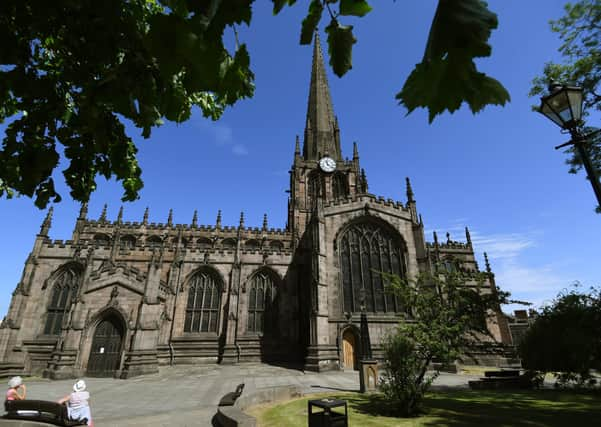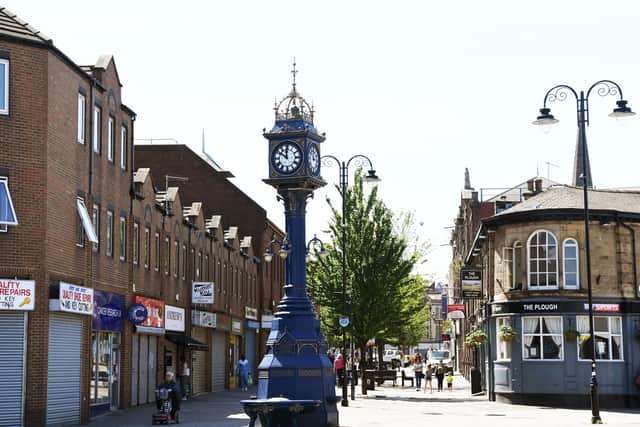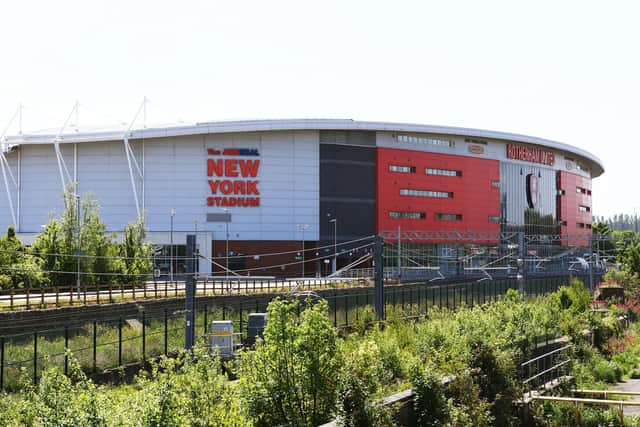How Rotherham’s story and redevelopment is bringing pride to locals


It’s a great mistake that so many people make – the idea that our ancestors were narrow-minded folk who hadn’t got a clue about what was going on over the brow of the nearest hill.
Finds in Yorkshire tell us that hundreds, even thousands, of years ago the people here were enjoying objects from all over Europe, and even further afield. They used spices from Asia and North Africa and they exported materials as well. We hewed coal, we built ships and made cloth. One of the most precious exports was right there under our feet. Good old native stone.
Advertisement
Hide AdAdvertisement
Hide AdMonks at Roche Abbey in South Yorkshire, within the Rotherham boundaries, built their home next to a gushing little stream, which still meanders through the site today. They were pretty savvy in selecting their site, because it stood on a seam of remarkable rock.


And as the Abbott and his monks oversaw the building of their place of worship they simultaneously developed an adjacent quarry, the sides of which can still be seen today, in a cliff that runs next to the ruins.
Word got around that the stone was of such quality and of such glowing colour, that a visitor to the abbey ordered tons of it to be sent south. So if you ever visit King’s College Chapel in Cambridge, look up, for that magnificent groined roof is of stone that came from Rotherham.
Roche (now in the care of English Heritage) is one of Yorkshire’s “forgotten” monastic estates, though it is just as fascinating as those at Rievaulx or Jervaulx. It was also the scene of what you could describe as a medieval example of canny Yorkshire recycling. When the dissolution of the monasteries was put into law in 1538, the good folk of Rotherham and the local area saw their opportunity. They descended on Roche and carted off the lead, stone and timber which were then used many times over in local buildings.


Advertisement
Hide AdAdvertisement
Hide AdOne of the town’s most impressive landmarks still sits serenely on the bridge over the River Don. The Chapel of Our Lady (built in 1483), is one of only four similar structures in the whole country. The sister of this “Yorkshire gem” is a few miles away in Wakefield, and both were used by weary travellers in the days of old. A light was lit in the Rotherham chapel every night to guide wayfarers into the town. In its time, it has also served as the town jail as well as a tobacconists’.
It was restored as a place of worship nearly 100 years ago and has long intrigued curious visitors. And if walls could talk it would have a story to tell about the pitched battle that took place here between Royalist and Parliamentary forces.
The Rev Phil Batchford is vicar at nearby Rotherham Minster. He was raised in Sheffield, and became vicar at the Minster three years ago, when the town was at a “low point”.
He feels Rotherham’s fortunes are back on the rise. “It was a bit like turning up just as winter was fading, and the new shoots of spring were coming through. There was definitely a new commitment from the town’s council to regenerate the place, to redevelop and grow.
Advertisement
Hide AdAdvertisement
Hide Ad“For me – and many others – the area around the Minster has been transformed beyond all recognition. The gardens are stunning, and the Heart of Steel sculpture is a beautiful piece of work.”
He has been impressed both by the town and its people. “We are going through a time of great transition, but there’s a lot of loyalty here and determination, too.”
The Minster is at the heart of the town’s history. Its verger, Martin Taylor, has served the church since long before it achieved Minster status back in 2004. He is a font of knowledge about the building, much of which dates back to the 15th century. It dominates the skyline sitting atop a hill, so that it can be seen for many miles around.
There is a poignant memorial on one of the side walls. Knowing the mining heritage of the area, you might think that this would be to commemorate a local pit disaster, but not so. It honours the victims of the Masbrough boat disaster, back in 1841.
Advertisement
Hide AdAdvertisement
Hide AdBack then there were thriving boatyards on the River Don and the Rother, and there was some excitement in the town about the launching of a ship called the John and William, from Chambers slipway. Because the Don is quite narrow here, larger vessels were launched sideways into the waters, and at Chambers they had a custom of inviting locals to not only watch the event from the shore, but also on board the boat.
On this occasion there was a gala atmosphere, including groups of schoolchildren. Many scrambled up on to the decks, possibly as many as 150. As the vessel slid towards the river there was a rush to get to the side that was going to hit the water first. This caused the ship to overbalance on its keel and capsize, throwing many on board into the water. Sixty-four people lost their lives, including 50 children.
The tragedy cut across the social barriers – several of the victims were the sons of wealthy local businessmen. A jury at the inquest later found that the event had been “a terrible accident”. The youngest two to perish were just five years old – Alfred Greenfield (whose brother aged 10 was also killed), and Henry Smith. A subscription to help the poorer families affected raised £200. But how much the fine memorial – which has lachrymose Victorian sentimental verses inscribed on it – cost, isn’t known.
The town was forged by heavy industry – mining, glass and steel-making all played a huge part in Rotherham’s story – so it’s hardly surprising that pollution blighted the town until only a few decades back. One resident recalls his mother leaving her home to cross the town centre, smartly dressed and proudly wearing a pair of brand-new nylon stockings. By the time she arrived at her destination, the stockings were filthy.
Advertisement
Hide AdAdvertisement
Hide AdAnd yet today, Rotherham is a verdant place. It’s a badge of local pride that the town has nearly 80 square miles of designated Green Belt land within its boundaries, which represents just over 70 per cent of the borough. That has been the case since 1979, and in recent years approaches to the town have been brightened by the sowing of lush wildflower meadows on verges and roundabouts.
Local businessman Chris Hamby is hugely optimistic about developing the town centre, and is inspired by many of the smaller enterprises that have set up in recent years.
Hamby, who owns the oldest secular building in Rotherham (The Three Cranes pub was built in 1470), believes this is where the town’s future prosperity lies. “
I really do believe that it’s a case of sending in a flotilla of small ships, which can turn around quickly, and adapt more easily, rather than relying on one single juggernaut.”
Advertisement
Hide AdAdvertisement
Hide AdThere are exciting plans in the pipeline, including the redevelopment of the Forge Island area which is a partnership between the council, Muse Developments and other organisations.
Culturally, Rotherham doesn’t always get the recognition it deserves. Sandy Powell was born here in 1900, went on the boards at the age of nine and was still entertaining audiences when he died in 1982. He even had a pub in Rotherham named after him, The Comedian. Then there’s Duggie Brown and Paul and Barry Elliott, aka the much-loved Chuckle Brothers.
The town is known, too, for its brass band heritage – a music scene that continues to thrive, while Clifton Park remains a popular venue for all manner of outdoor concerts and festivals.
Rotherham may have had to endure more than its fair share of battles, but those days, hopefully, are a thing of the past.
Advertisement
Hide AdAdvertisement
Hide AdEditor’s note: first and foremost - and rarely have I written down these words with more sincerity - I hope this finds you well.
Almost certainly you are here because you value the quality and the integrity of the journalism produced by The Yorkshire Post’s journalists - almost all of which live alongside you in Yorkshire, spending the wages they earn with Yorkshire businesses - who last year took this title to the industry watchdog’s Most Trusted Newspaper in Britain accolade.
And that is why I must make an urgent request of you: as advertising revenue declines, your support becomes evermore crucial to the maintenance of the journalistic standards expected of The Yorkshire Post. If you can, safely, please buy a paper or take up a subscription. We want to continue to make you proud of Yorkshire’s National Newspaper but we are going to need your help.
Postal subscription copies can be ordered by calling 0330 4030066 or by emailing [email protected]. Vouchers, to be exchanged at retail sales outlets - our newsagents need you, too - can be subscribed to by contacting subscriptions on 0330 1235950 or by visiting www.localsubsplus.co.uk where you should select The Yorkshire Post from the list of titles available.
Advertisement
Hide AdAdvertisement
Hide AdIf you want to help right now, download our tablet app from the App / Play Stores. Every contribution you make helps to provide this county with the best regional journalism in the country.
Sincerely. Thank you.
James Mitchinson
Editor